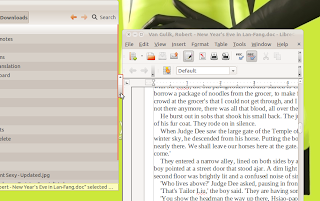Ubuntu has always been excellent with hardware compatibility and its support for an endless number of application makes it one of the more dependable Linux distributions to have on a network. However, I am slowly realizing the productivity limits of Ubuntu Unity. I agree that Unity is still superior to Gnome 3 in terms of productivity. However, the uniqueness of Dash and the Launcher quickly wore off. I found myself wishing for the efficiency of openSUSE's traditional Plasma interface with its "so-1990's" KDE Kickoff menu and "so-Vista" widgets.
 |
| Surprisingly, the "Unity Scroll bar" doesn't affect LibreOffice. |
There is no denying that Ubuntu is still as good as ever as an operating system - I still prefer it over Windows any day of the week. However, more and more I'm beginning to realize the impact of Unity. I stand by my initial review that Unity is an attractive interface, but I understand why the power user loathes it - I can imagine white-haired Linux gurus swearing and spitting at the monitor as they press ALT+F2.
 |
| Dash can be inconsistent |
I get bored with desktop environments easily and welcome the change, but I've struggled to get used to the navigation and horribly intrusive Alt+F2 Dash. When Adobe Reader for Linux, which worked fine in 10.10, openSUSE 11-12.1, and Fedora, displayed interface issues in Unity 11.10, I knew I had made a mistake.
 |
| Adobe Reader 9 does not function properly in Ubuntu Unity (works in openSUSE, Mandriva, and Fedora though) |
The KDE and Gnome Application Compatibility Conundrum
Every Linux user is aware that not all KDE applications work perfectly in Gnome 2-3 and not all Gnome-based utility will install perfectly on KDE. Common sense dictated that a user would install an application that would work best on the environment installed on their system. Pybliography, for instance, works better in Gnome than in KDE. KSnapshot, a screen-capture utility, is best on KDE.
The aforementioned Pybliography failed to work properly in Unity. Pybliography, a Gnome utility, had a slight performance issue in KDE but at least it worked - in Unity it was unusable. All other applications worked after installation (e.g. Kompozer, Google Chrome, Shutter, etc.) but I couldn't help but wonder how many other applications would have issues with Unity.
The Desktop Environment is NOT the Linux Distribution
I haven't dismissed Ubuntu Unity 11.10. It's easy to hate a distribution because of its interface. At the moment, it doesn't take much effort to throw rocks at Ubuntu because of Unity. The truth is users can opt for Kubuntu and Lubuntu, both well-loved Ubuntu spins. I personally loved Lubuntu 11.10 and would install it on the Z360 (though I would be wasting the laptop's Nvidia 1GB VRAM and Core i3 hardware).
| Getting used to the Menu appearing only when moused over is more difficult than that Office 2007 Ribbon everyone complained about. |
In fact, there are many ways to configure Unity (MyUnity), to make it more similar to Gnome 2 and circumvent user interface issues. I have great respect for the guys over at Canonical. My minor hiccups with the Desktop switcher, Pybliography, and Adobe Reader were disappointing, but they weren't deal-breakers. Perhaps Unity, like Xfce, just isn't for me.
My only regret is that I assumed Ubuntu Unity would be appropriate for a production laptop. For that openSUSE 12.1, which is running perfectly on my underpowered netbook, should have been a better choice.
















0 comments:
Post a Comment